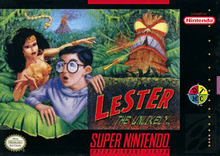Lester the Unlikely
Lester the Unlikely is a 1993 platform video game developed by Visual Concepts for the Super Nintendo Entertainment System (SNES).
| Lester the Unlikely | |
|---|---|
 Cover art by Michel Bohbot | |
| Developer(s) | Visual Concepts |
| Publisher(s) | DTMC |
| Designer(s) | Jeffrey J. Thomas |
| Programmer(s) | Brian Greenstone |
| Composer(s) | Byte-Size Sound: Matt Scott Mike Cihak |
| Platform(s) | Super NES |
| Release |
|
| Genre(s) | Platform action game |
| Mode(s) | Single-player |
Plot
In the beginning, a teenage boy named Lester, who is "kind of geeky" and "kind of sleepy" recently got a new issue of the Super Duper Hero Squad comic book. He was reading it while walking on a dock, until he fell asleep next to a cargo crate lying beside a cargo ship. After he and the cargo were loaded onto the ship by a crane and cruised off, the ship got hijacked by pirates who scuttled it. Lester luckily found a life jacket and swam toward the most adjacent island while the cargo ship sank. Lester must find his way home by exploring the island for someone or something that can help him survive.
Development
Bill Stanton was the lead artist on the project and handled backgrounds, tiles, sprites and adapting rotoscope animations. Michel Bohbot created the cover art. Eric Browning, a lead artist for Visual Concepts (as well as the voice of Lester), acted as the rotoscope model for the lead character. Browning described it as "one of those games that starts out way too ambitious, and ends up merely adequate."[1] Lester the Unlikely was one of six SNES games programmed by Brian Greenstone of Pangea Software.[2] On the Pangea website, Greenstone wrote "Lester was a game I never liked. Don't wanna talk about it."[3]
A conversion for the Atari Jaguar was in development and planned to be published by DTMC, but it was never released.[4][5][6][7]
Critical reception
| Reception | ||||||||
|---|---|---|---|---|---|---|---|---|
| ||||||||
A review from Nintendo Power scored it a 3.7 out of 5, praising the animation which they noted similar to Prince of Persia and the difficulty. They did, however, dislike the limited amount of continues for a game that would require the player to experiment a lot in order to beat the game.[8]
References
- "Snes Central: Eric Browning Interview". www.snescentral.com. Archived from the original on 2016-07-19. Retrieved 2016-08-11.
- "The Covert Gaming Corner - Interview: Brian Greenstone". legacy.macnn.com. Archived from the original on 2016-03-04. Retrieved 2016-08-11.
- "Pangea Software: Other Games". www.pangeasoft.net. Archived from the original on 2017-03-30. Retrieved 2016-08-11.
- "Action Feature - Jaguar Previews - The Jaguar moves in". Atari ST User. No. 99. Europress. April 1994. pp. 64–69.
- "The Game Fan 32Bit System Shoot Out - Who Will Lead Us Into The Next Generation?". GameFan. Vol. 2 no. 7. Shinno Media. June 1994. pp. 146–147.
- "Update Games News - Atari ooze confidence at ECTS - Jaguar Developers". ST Format. No. 59. Future plc. June 1994. pp. 56–57. Archived from the original on 2018-09-27. Retrieved 2018-09-21.
- "CVG News - Jag attack... eyes down". Computer and Video Games. No. 154. Future Publishing. September 1994. p. 9.
- Nintendo Power. February 1994. Volume 57. pp. 104, 107.
External links
- Lester the Unlikely at MobyGames
- Lester the Unlikely at SNESMusic.org
- Michel Bohbot Illustration at www.mbohbot.com